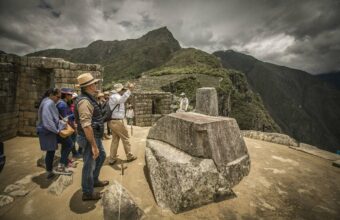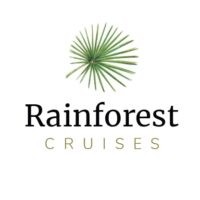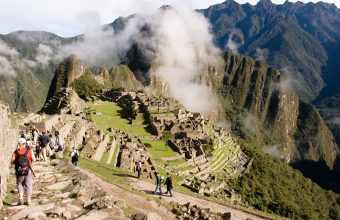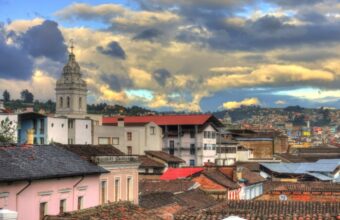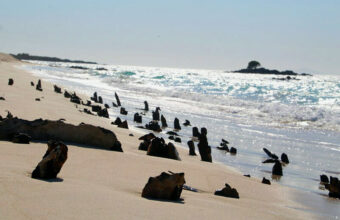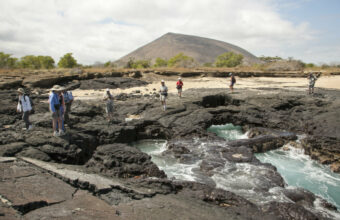The Best Galapagos Islands Cruises
An essential guide to cruising the Galapagos Islands
Step aside, humans. The protagonists of the Galapagos Islands’ history are the rare and endemic species that populate this far-flung chain of volcanic islands in the Pacific.
As Charles Darwin discovered on his famous voyage on the HMS Beagle in 1835, the natural history of these dynamic islands reveals the fits and starts of evolution itself.
Humans only arrived on the scene fairly recently, all too often as the villain of the plot. 16th century Spanish explorers were appalled by the stark volcanic landscape, calling the islands a hell on earth. Pirates and whalers used the islands opportunistically, capturing and killing wildlife en masse. Most recently, habitats have been threatened by invasive species introduced by humans, as well as the strains of a growing resident population and tourism trade.
As part of the carefully-managed tourism model, guests are accompanied by local, certified naturalists guides. These guides bring the natural and human history of the islands to life. Visitors learn about their own complex role in the Galapagos narrative.
There's no escaping it: a visit to the islands isn't the cheapest (or simplest) trip you can take. But it needn't break the bank, or be excessively complicated. Here's how to narrow down the options and choose the best Galapagos cruise for your group.
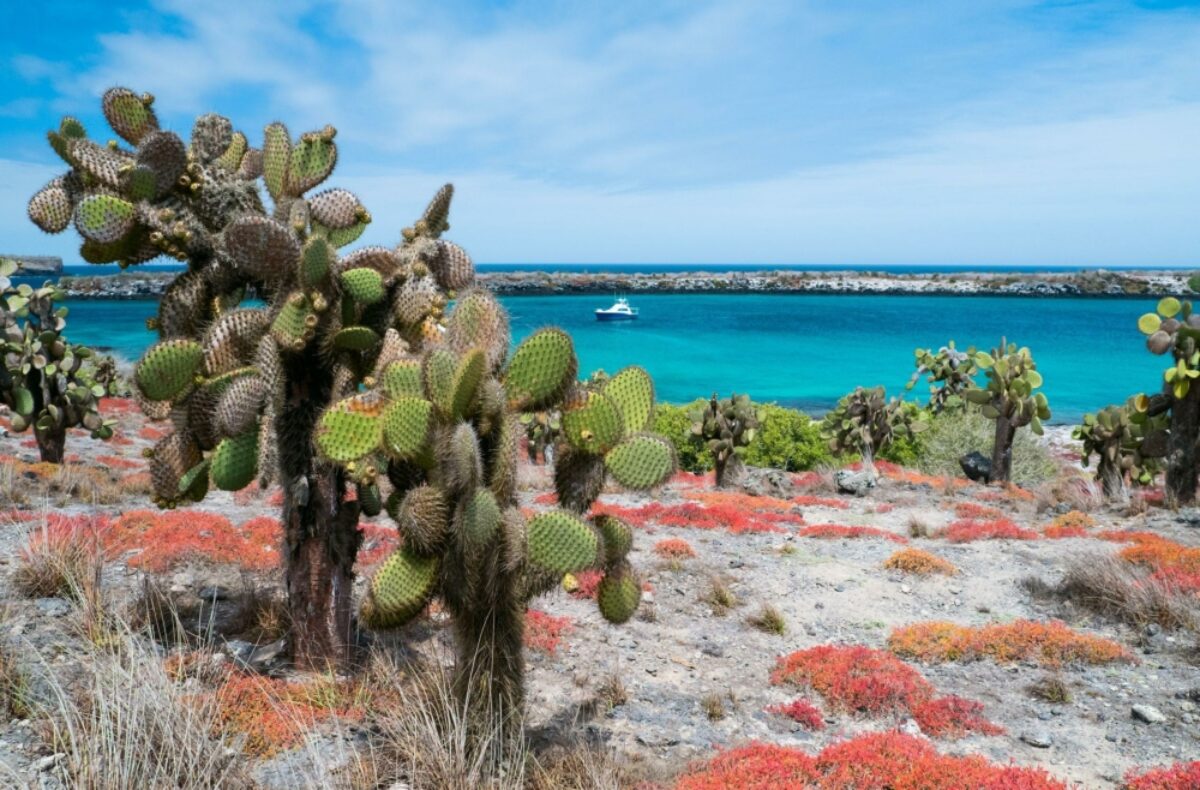
Plaza Island, on the Galapagos archipelago
How do you get to the Galapagos Islands?
The Galapagos Islands are only reachable by air from mainland Ecuador, departing either from Quito, Ecuador’s capital, or the coastal city of Guayaquil. There are no sea connections or international flights direct to the islands.
If you fly from Quito you’ll probably stop en-route in Guayaquil to pick up additional passengers, but you won’t deplane. You’ll either fly directly to Baltra (the main Galapagos airport) or San Cristobal (the secondary Galapagos airport). The flight time from Guayaquil is about 1.5 hours.
Most tour operators will insist on a full day in either Quito or Guayaquil before your flight to the islands, in case of delays on international flights – the cruise ships won’t wait for anyone!
Quito or Guayaquil?
When choosing which airport in Ecuador to arrive at, keep in mind the following:
Quito is a gem of a colonial capital city, and is worth spending at least a day and a night in. It has a thriving art, music, and restaurant scene, as well as a bevy of historic sights to discover. However, its new international airport is far from the city centre (45 mins to one hour drive), adding airport transit time to the itinerary.
Guayaquil is a more industrial-looking port city, without the charms of Quito. The advantages are shorter and more direct flights to the Galapagos and easier access to the airport.
When searching for international flights, compare fares to both cities. A good combination is to arrive in Quito and depart from Guayaquil, or vice-versa. Remember that there is so much more to Ecuador than the Galapagos Islands—if you’re flying all this way you should try to make time for the rest of the country if at all possible.
What is the best way to see the Galapagos Islands?
There are three broad categories of Galapagos trips: cruises, hotel/lodge stays, and island-hopping trips. Which you choose depends on your preferred travel activities and flexibility. (See also: Galapagos cruises vs land tours.)
Cruises are organised in itineraries of eight days, five days and four days. Longer cruises have the benefit of reaching farther, less-visited sites. Shorter cruises are easier to combine with a land-based experience of the Galapagos and other stops in Ecuador and beyond (the Galapagos & Machu Picchu is a common combination).
Single hotel/lodge trips on the inhabited islands also tend to be organised as packages with fixed durations. Only four islands are inhabited with lodging: Santa Cruz, Isabela, Floreana, and San Cristobal. Isabela and Floreana are less-populated and the lodges tend to be more basic, with fewer amenities but fewer crowds. The hotel will organise daily activities such as day trips by speedboat to neighbouring islands and guided nature-spotting excursions.
The third option is an island hopping trip, where you stay at different lodges on various islands, linked by short flights or speedboats.
How to choose the best Galapagos cruise
Once you start researching vessels and cruise lines you’ll quickly discover there’s a huge range of ship classes and sizes, and a variety of itineraries and activities.
To choose the best cruise for you, start by deciding on a price and duration that feels right. Then you can browse the various ships and itineraries that best fit. Here’s an overview of what the various options mean:
Ship classes
As you browse cruise lines you’ll encounter various categories of boats operating in the Galapagos: Economy / Tourist, Tourist Superior, First, and Luxury class.
Tourist or Economy class
As the label suggests, Tourist or Economy class boats can be good value but with basic accommodation, less shared space, and little or no on-board amenities. Don’t expect air conditioning, hot water may not be guaranteed, you may be sharing bathrooms, and the food will be satisfactory but basic.
Tourist Superior class
Tourist Superior ships have more spacious and comfortable rooms with private hot water bathrooms and air-conditioning plus more amenities and better food. Check the deck plan as some rooms may be below deck or closer to the engines.
First class
First class boats have more room, fewer passengers, good food, and additional crew like a cruise director to help keep things informative. There may be extra facilities, such as a glass-bottomed boat and paddle boards and, depending on ship size, a fitness room, hot tub, library, and separate bar/lounge areas.
Luxury class
Luxury class boats may be bigger making them more stable, but with fewer passengers—sometimes as few as eight—affording a sense of exclusivity and solitude. At this level the dining is part of the experience, with a world-class on board chef, along with expert naturalist guides at the top of their field.
Ship type & size
There are a variety of vessels plying the waters of the Galapagos, including catamarans, motor sailboats, and larger cruise ships.
In the Galapagos, “large” ships are only relatively large, up to a maximum of 100 passengers with 30-40 crew – clearly not your average Caribbean cruise liner! And small can be tiny, down to just eight passengers on the smallest.
Large ships obviously have more facilities, bigger deck spaces and more social areas, but are not necessarily more luxurious than the smaller ships. Higher cabins have better views, but they’re usually more expensive and will feel rockier in strong seas.
Smaller ships are able to anchor closer to the islands, but this is less important considering that all ships use small boats to land on the islands. Remember that smaller boats will pitch further in choppy seas, so those susceptible to seasickness should bring Dramamine or equivalents. Catamarans tend to be the most stable vessels.
Activities & itineraries
The final factor to consider is the particular itinerary. Ships operate on a 14 day rotation visiting different landing points on the islands. They’ll typically be following a full itinerary, with passengers leaving or joining for shorter segments throughout. Four and five day itineraries focus on the inner islands, longer cruises make it further afield to quieter islands and landing points.
How long do you need in the Galapagos?
To do the Galapagos justice, aim to spend at least five days on the islands, either on a cruise or a land-based tour. Four-day/three-night cruises are available but will feel rushed and won’t get beyond the busier inner islands.
Five-day cruises generally rotate around the main inner islands, plus one or two outer islands. This will give you a balanced view of the islands and a good range of wildlife, without everything feeling too rushed.
For example, the Comorant five-day eastern itinerary starts at Baltra and visits Santa Cruz, Genovesa, South Plaza, Santa Fe and San Cristobal, with morning and afternoon excursions at each stop. Or the five-day Ocean Spray western itinerary, which heads from Baltra to Bartholomew, Genovesa, Santiago and back via Santa Cruz.
Seven and eight-day cruises tend to be the sweet spot if you have the time and budget. They generally head to the quieter western side of the islands and give you time for a greater range of activities and excursions.
For instance, the Petrel eight-day itinerary heads straight to the western side of Isabela, via Fernandina, with excursions at Espinosa Point, Tagus Cove, Urbina Bay, among many others before returning via Santa Cruz, South Plaza, Santa Fe and San Cristobal.
Longer cruises are available, but after two weeks the novelty will likely have worn off and the itinerary will include plenty of padding with lots of “free time” and rest days on the beach.
Unless you’re doing something specialist such as a diving course or a birdwatching cruise, two weeks is probably too much—use your spare time on the mainland instead, the rest of Ecuador is just as fascinating!
Life on board a Galapagos cruise
Life onboard Galapagos cruise ships revolve around early starts and action-packed days. Mornings consist of wake up calls, breakfast buffets and gearing up for trips to the uninhabited islands.
Travel from ships to shore is done via pangas (small, motorised rubber boats) that are swift and used for both wet and dry landings.
The majority of the day on a cruise is spent exploring different islands. Normally there are activities such as hikes and snorkelling in the morning, followed by lunch on the ship, and an afternoon excursion to another part of the island.
After spending most of the day out exploring, evenings are reserved for relaxing. There is usually a briefing in the evening with your guide to go over the next day’s destination. Depending on the boat these can detail activities for the next day, be presentations about the islands, activities geared towards children, dancing, or time to talk about the day’s events. The ship will sail overnight and you’ll awake in a new location to start all over again!
Accommodation and lodging
Accommodation standards vary depending on the level of boat you stay on. The deluxe cruises go all out with luxury rooms, balconies and amenities you would expect in a five star hotel. Others maximise space with more rooms and more passengers. On most ships, there is an inherent trust and things like locks on doors don’t exist. Theft isn’t a concern in the islands, but consider bringing bags with locks for valuables if you’re worried.
One thing to consider when choosing a cruise is where the rooms are located. Rooms lower in the water are calmer when it comes to the open sea and can reduce the risk of seasickness. The other side of the coin is they are also closer to the engine room.
Food and drink
Breakfast and lunch are normally buffets with an ample choice of international and Ecuadorian food to choose from. Breakfast includes fruit and juice, while lunch gives you chicken or meat dishes and Ecuadorian-style seafood along with salads and vegetarian options.
Dinner is normally a more formal affair with a choice of main course and pre- and post-dinner drinks with other guests. Some of the boats include your bar tab in the price, but typically you can expect to pay for alcohol, tips and any other extras.
Dealing with bad weather
When the weather gets rough the crew decides the agenda for the day. Typically storms only last a short time. If you are out exploring and rain sets in, your guides might decide to head back to the ship until the weather subsides. If it clouds over and is only a light storm, you might be given the option of going out to the islands with appropriate gear.
At times the sea can be choppy, and many passengers take sea sickness pills as a precaution. Normally after a few days people have adjusted. If seasickness is a major concern for you, catamarans are the steadiest crafts that operate in the islands.
Galapagos FAQs
What’s the local currency?
The US$ is the official currency of Ecuador, so no standing in line at currency exchange if you’re travelling from the USA.
Do you need a visa to visit the Galapagos Islands?
Visitors from North America and most European countries don’t currently need a visa to enter Ecuador, but please double check before departure. Your passport must be valid for at least six months beyond the date of departure from Ecuador.
In addition to the originals, bring a copy of your passport, a list of identity card numbers and the international phone numbers of their issuing institutions. Store these separately from your original documents in case of an unforeseen problem with emergency contact numbers and medical information.
Valid health insurance is also required to travel to the Islands. Check that you are covered for emergency air transport as there are only basic facilities on the Islands.
What gadgets should I bring?
Pack extra SD cards, cables, chargers and batteries for computers, electronics and phones. Even in Quito and Guayaquil, accessories for major brands are hard to find and extremely expensive due to high import taxes. A point-and-shoot camera is useful for moments when taking out expensive photography gear is impractical.
Will my cell phone work in the Galapagos?
Cell phones on GSM networks generally work on the inhabited islands. Check with your provider to find out the specifics of your plan and the roaming charges. Extremely high rates are common, and it’s better to know beforehand to avoid the shock after returning home. It’s always wise to turn off data roaming before heading abroad.
At the airport in both Quito and Guayaquil you can buy travellers’ sim cards for your stay in Ecuador. These use a pay as you go system, and don’t require an Ecuadorian ID to activate.
Is there internet on Galapagos cruise boats?
Internet in the Galapagos pales in comparison with the speeds of the United States and Europe. Most hotels have connections, but expect limited range, slow loading times and long waits. Internet on board cruise ships is generally unheard of, or will be via satellite connections at exorbitant pricing—for emergencies only, if at all. Much better to plan to do without and enjoy your surroundings!
How much should I tip?
In restaurants, a 10% service charge is added to the bill; for crew, drivers and staff, $5-10 a day is fair. For guides and trip leaders, $10-15 dollars a day is the norm. Note that apart from tourism destinations, tipping isn’t typical and what you leave is entirely up to you.
What are the luggage restrictions?
Most airlines restrict luggage to one checked bag up to a maximum of 40 pounds and one carry-on bag that weighs up to 15 pounds. This is generally recommended for all air travel within South America. Extra baggage can usually be accommodated for a fee.
Are land-based trips better for avoiding sea-sickness?
Not necessarily. Although land-based trips mean spending the night in hotels or lodges you’ll still visit various islands by boat – usually small speedboats, which can be extremely choppy and can cause problems for younger and older travellers.
Can I roam the islands solo?
Visitors on cruises to uninhabited islands are required to be accompanied by a registered guide for their own safety and for the protection of the islands. You can rent bikes, kayaks, and snorkel equipment and spend days exploring the inhabited islands of Santa Cruz, San Cristobal, Floreana, and Isabela.
Packing list for the Galapagos Islands
Pack light, quick-drying clothes for the Galapagos. Heavier materials such as cotton take longer to dry in the humid weather. Remember that you’ll be travelling on boats (including pangas and rafts with dry and wet landings) and that you’ll need waterproof clothing. It’s also worth packing seasickness tablets to help you cope with the rocky journeys to the islands.
Basics to pack for a trip to the Galapagos Islands include:
- Sturdy hiking boots
- Rain jacket
- Waterproof trousers
- Waterproof bag for electronics
- Sunscreen
- Sunhat
- Breathable hiking socks
- Water bottle
- Seasickness tablets
- Fleece and wind-shell

